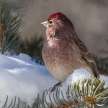
Tepui Tinamou, a mere Venezuelan endemic, is unquestionably one of the most elusive tinamous. In the southern state of Bolívar, where its global range is estimated at just over 400 km2, it is so far known only from three tepuis. His voice has only recently been reported with certainty, and therefore the population may still be more widespread than it is now known. This long tinamou was known from only two peaks in its present-day established distribution area in the southwest. Most of the limited geographic range of this species remains unavailable, and therefore populations of Tepui Tinamou are not considered in danger. Tepui Tinamou inhabits dense subtropical cloud forests at an altitude of 1350–1800 m, and its life history is almost entirely unknown. Tepui Tinamou is a medium-high, dark ruddy brown tinamou, without barring or spotting, but is more rufescent over the breast, with white cheeks and throat. Tinamous are aquatic stormy birds with very small tails and round wings. Tepui Tinamou is a medium-height pale-eyed tinamou, with a short, clear nose. The upper and bottom parts are completely soothy chestnut, while the head nose and sides are soothy brown. At breast Rufous is tinged. The remaining underparts are generallt slightly paler and grayer. The same gender. Tepui Tinamou that overlaps with Little Tinamou (Crypturellus soui), but Little Tinamou, with a black iris, is smaller and brighter. Cinereous Tinamou (Crypturellus cinereus) is confined to lower elevations, is soothy grey, lacks the chestnut shades of Tepui Tinamou and has a black iris. Red-legged Tinamou (Crypturellus erythropus) has red tarsi, upper barred sections, and is a browner overall. Tepui Tinamou is only known from a few locations in the tepui region of south-east Venezuela. The initial series of specimens were collected on Ptari-tepui and Sororopán-tepui; more recently, it was also collected on Auyán-tepui. The Sierra de Lema also includes details about visibility. They are native to the Americas. Tepui Tinamou takes place in thick mountain forests and in more open scrubby areas. The tepui eats fruit from the ground like other tinamous animals, or low-lying bushes. They also consume small amounts of invertebrates, blossoms, tender herbs, seeds, and roots. The male incubates the eggs which can come from as many as four different females, and then holds them up until they can be autonomous, normally 2–3 weeks. The nest is on the ground in dense brush, in raised root buttresses. The tepui takes fruit like other tinamous, or low-lying trees from the forest. We do consume small numbers of invertebrates, seeds, tender herbs, berries, and roots. The male incubates the eggs which can come from as many as four different females, and then they hold them up until they can be autonomous, normally 2–3 weeks. The nest is on the ground in dense scrub, under elevated root buttresses. The IUCN classifies it as the Least Concern, with an frequency of no more than 1,000 km2. Venezuela is a dangerous species. The inlinemedia of Tepui Tinamou is "a deep, pure whistle of tone at the same note, the last half fading away." Like for many populations of tinamou, when the bird is flushed the wings usually make a whistling sound. Tepui Tinamou forages on the ground, but otherwise very little is known about this species ' behaviour. Tepui Tinamou is secretive and seldom seen as is typical of other tinamous forest-inhabiting species. From what is known of the breeding system of other species, "the general rule for tinamous is simultaneous polygyny for males and sequential polyandry for femalesTepui Tinamou is possibly solitary, as are other tinamous species in the jungle.
About the Creator
MB
I am a bird aficionado and really enjoy spotting them them on hikes. I greatly appreciate the variety of birds cross North America and the world. They are amazing and intelligent creatures, each so unique and with a wonderful life.






Comments
There are no comments for this story
Be the first to respond and start the conversation.